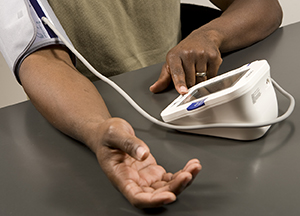Checking Your Blood Pressure at Home
Keeping track of your blood pressure at home can be a good way for you and your healthcare provider to learn how your blood pressure changes during the day. You can use one of two types of blood pressure monitors. Each has pros and cons.

Aneroid monitors
This type of monitor has a cuff that you inflate by hand and a dial gauge with a pointer. Most models are easy to carry. They are often inexpensive. Some models have easy-to-read gauges and a special cuff that lets you work it with one hand. These monitors need to be adjusted at least once a year. These are very accurate but can be hard to read.
Digital monitors
These monitors are easy to use and read. Most digital monitors are portable and can be used with one hand. Keep in mind that digital monitors are sensitive to body movement. They don't work well on certain people. They also need electricity or batteries and are more expensive than aneroid monitors.
Talk with your healthcare provider about which type might be best for you. No matter what kind of monitor you use, take it with you to your provider's office. You can compare it with the monitor in the office and check that it is accurate.
Tips for buying a blood pressure monitor
-
The American Heart Association (AHA) recommends an automatic monitor that uses a cuff that goes on your upper arm (bicep).
-
The AHA doesn't recommend wrist and finger monitors. This is because their results are not as reliable as the upper arm monitors.
-
Check that the monitor meets the U.S. Blood Pressure Validated Device Listing criteria. See www.validatebp.org for more information.
-
Check that the monitor is approved for children, pregnant women, and older adults if it's to be used for these groups.
-
People with smaller or larger arms may need a special cuff size. Measure around the upper arm. Choose a monitor that comes with the correct cuff size.
-
Check your monitor's reading with your healthcare provider's reading when the device is new. Check it once a year after that.
-
Monitors can wear out over time. They may no longer be able to be adjusted. You may have to replace your monitor if the measurements are very different from the measurements made at your provider's office.
Online Medical Reviewer:
Ronald Karlin MD
Online Medical Reviewer:
Stacey Wojcik MBA BSN RN
Online Medical Reviewer:
Steven Kang MD
Date Last Reviewed:
7/1/2023
Copyright Health Ink & Vitality Communications